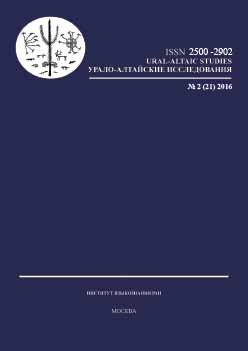Ударение в непроизводных именах с однородным вокалическим составом в ямальском диалекте тундрового ненецкого языка. Часть I. Фонетические слова с гласными нижнего и среднего подъемов
Stress in underived nouns with homogeneous vocalic structure in the Yamal dialect of Tundra Nenets. Part I. Phonetic words with low and middle vowels
Author(s): Maria Konstantinovna AmelinSubject(s): Phonetics / Phonology, Lexis, Sociolinguistics, Present Times (2010 - today)
Published by: Институт языкознания Российской академии наук
Keywords: Tundra Nenets; the Yamal dialect; stress; word accent; acoustic correlates of stress;
Summary/Abstract: The article takes into account the field data collected by the author during work with native speakers of the Yamal dialect of Tundra Nenets in the Tambey tundra and Syo-Yakha (Yamalsky municipal district, Yamalo-Nenets Autonomous Okrug) in April―September 2010. The article deals with the problems of suprasegmental phonetics of the Yamal dialect (idiom of Syo-Yakha and the Tambey tundra of the Yamalsky municipal district). In it, basic and secondary acoustic correlates of stress (word accent) in the disyllabic underived nouns with homogeneous vocalic structure (with low and middle vowels) in the Yamal dialect are considered. The combinatorics of the primary and secondary acoustic correlates of stress in the Yamal dialect is also considered and the conclusion is made that the word accent in the Yamal dialect is expiratory and quantitative, i. e. the main acoustic correlates of stress are temporal marking and expiratory marking of a stressed vowel compared with the unstressed. While marking of a stressed vowel of the first syllable is mainly based on the expiratory emphasis, marking of a stressed vowel of the second syllable is based on the temporal emphasis, and that is explained by the general language tendencies (long pronunciation of the final open syllable and more loud and intense pronunciation of the beginning of a phonetic word compared with the end).
Journal: Урало-алтайские исследования
- Issue Year: 2016
- Issue No: 02 (21)
- Page Range: 7-82
- Page Count: 76
- Language: Russian

